Amrita Yoga
If the real principles behind yoga are understood and practiced, we will be able to imbibe many other values such as patience, forgiveness, and forbearance. It will also develop the love within us.
—Amma
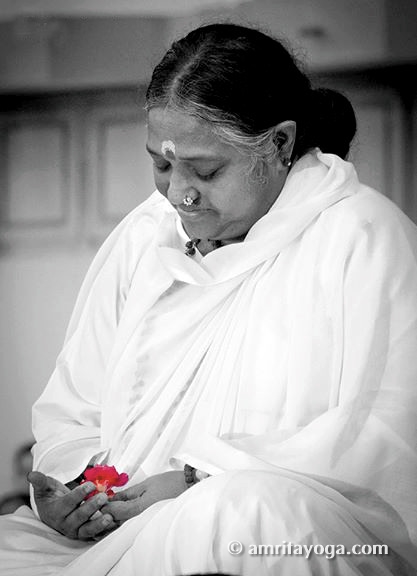
Our story
Amrita Yoga is rooted in the ancient Gurukul yoga tradition and yet is an entirely new approach to yoga practice based on Amma’s core philosophy of Living from the Heart. Amma’s spiritual teachings form the foundation of Amrita Yoga. The teaching style is intended to reflect the simplicity and humility of Amma.
Amrita Yoga stems from origins that have been part of India’s lifestyle from time immemorial. Families practiced yoga together in the same way they ate, worked, and worshiped. Yoga practice has been a part of sadhana (spiritual practices) since the Amritapuri Ashram began. Since the early years, Amma has always viewed hatha yoga as an integral part of our healthy daily life. Initiated in 1983, and ever since then, yoga classes at the ashram and centers have been based on Amma’s message of Living from the Heart.
The first formal Amrita Yoga class was introduced at Amritapuri in 2004 for Amrita University students and various Amrita Vidyalayam schools in India. The unique teaching methodology of Amrita Yoga was formalized in 2007. Since then, Amrita Yoga has been offered to all age groups of Indians and Internationals visiting Amritapuri and our centers worldwide.
Early outreach
In the busy modern world of India, reviving the ancient universal values is more important than ever to maintain a healthy body and mind. From the very beginning, Amma guided the yoga program to ensure it followed the highest tenets of Sanatana Dharma (Eternal Wisdom), India’s philosophy, and ancient traditions.
For this reason, the ashram has offered yoga classes since its early days. Teachers from Amritapuri and elsewhere traveled to many cities and villages to provide yoga classes for all interested.
Yoga has always been a part of Amma’s ashram. In the early days, the visitors and brahmacharis (practicing monks and nuns) would meditate for more than eight hours a day. Each person had a minimum practice of Surya Namaskar (Sun salutations), an asana series expressing gratitude and connection to the source of wisdom symbolized by the Sun or Lord Surya—a transcendent expression of the inner Self.
Accordingly, trained disciples of Mata Amritanandamayi Math began teaching yoga from 1983 onwards. Later, starting in the 1990s at the Amritapuri ashram, the roof of the Kali Temple was used one day a week for meditation, yogasanas, satsang, prasad, and darshan. At this time, yoga began being offered regularly at Amma’s ashrams throughout India.
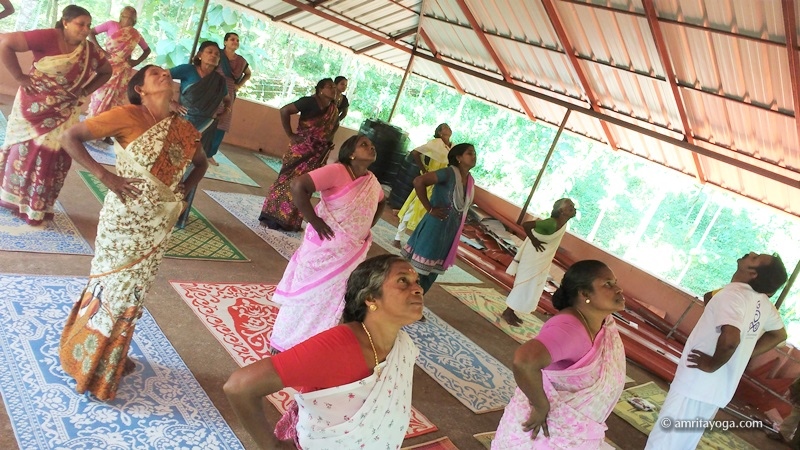
Formalized
Under Amma’s guidance, Brahmacharini Shobha was tasked with formalizing a yoga school following Amma’s vision. As a result, Amrita Yoga classes were formally introduced at Amritapuri in 2004 for Amrita Vishwa Vidyapeetham students and various Amrita Vidyalayam schools in India. In 2017, the Department of Amrita Yoga was formalized under Amrita Darshanam, International Center for Spiritual Studies at Amrita Vishwa Vidyapeetham, Amritapuri Campus. The Director of Amrita Yoga, Brahmacharini Shobha, is the head of this department.
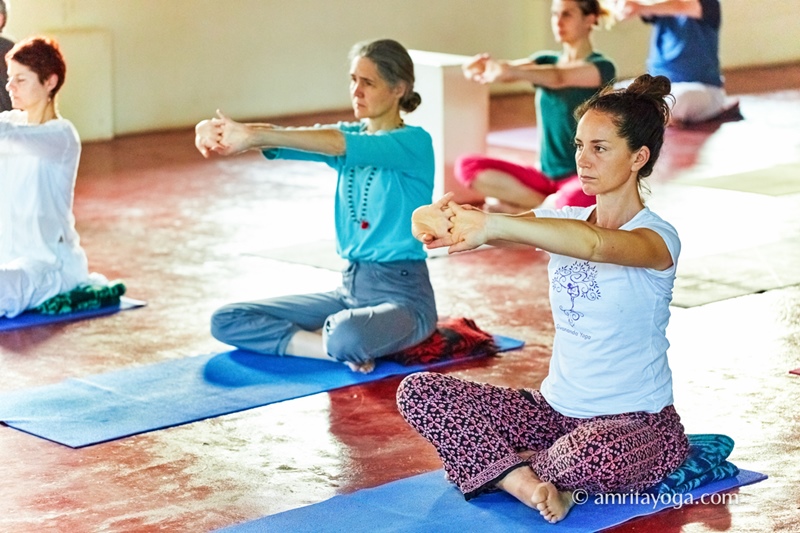
Our presence
Amrita Yoga, Amrita Vishwa Vidyapeetham is a member institution of the Indian Yoga Association (IYA), a self-regulatory body bringing leading yoga institutions together under one umbrella. IYA was established on 31st October 2008 and approved by the Ministry of AYUSH, Government of India. Amrita Yoga’s Director, Brahmacharini Shobha, serves on the twelve-member Committee for Yoga Education in Universities, set up in 2016 by the Indian Ministry of HRD. She is also the Joint Secretary of the Indian Yoga Association.
Living yoga
Yoga practice is about connecting with the Self to live a truly integrated life. Since time immemorial, families in India have practiced yoga together, in the same way that they ate, worked, and worshipped together. Yoga benefits both body and mind. From the beginning of the Amritapuri ashram, Amma has encouraged all her children to follow a balanced, healthy lifestyle that includes daily sadhana with yoga practices and simple living.
Amma’s commitment to yoga
Amma’s conversations on yoga with ashram visitors and residents demonstrate her commitment to upholding the lifestyle and wisdom of ancient India. Amma often emphasizes the four main paths of yoga and how they complement each other: “Yogasanas can be performed in two different ways, as a meditation technique and an exercise for the internal organs.”
In Awaken, Children! Amma discusses living yoga in day-to-day life. It is not just about a daily asana practice on the mat for 20 to 60 minutes, but the discipline of the spiritual union as the basis of all thought and action. It is the connection to the essence of life itself. Thus, yoga practice is not just a part of life but is the substratum underlying every action, every movement, and every breath of our life.
Gretchen Kusuma McGregor, a resident of Amritapuri since 1985, writes In the Shelter of Her Arms: “One morning, Amma called me to her room shortly after breakfast. Someone had mentioned that I knew hatha yoga, and she wanted to see my yoga postures.” At the end of her demonstration, and with Amma’s most memorable participation, Kusuma was asked to teach yoga to the ashram residents.
Throughout the 90s, one day a week under the green roof of the Kali Temple, Amma led meditations and gave satsang, darshan, and prasad. At noon Amma would lead the group through a few simple postures ending with 15-20 minutes of Savasana.
Several of us have witnessed Amma demonstrating the highest state of breath retention, effortlessly floating like a lotus leaf in the ashram pool, a special kind of pranayama called Plavini Pranayama, as mentioned in the yoga scriptures.
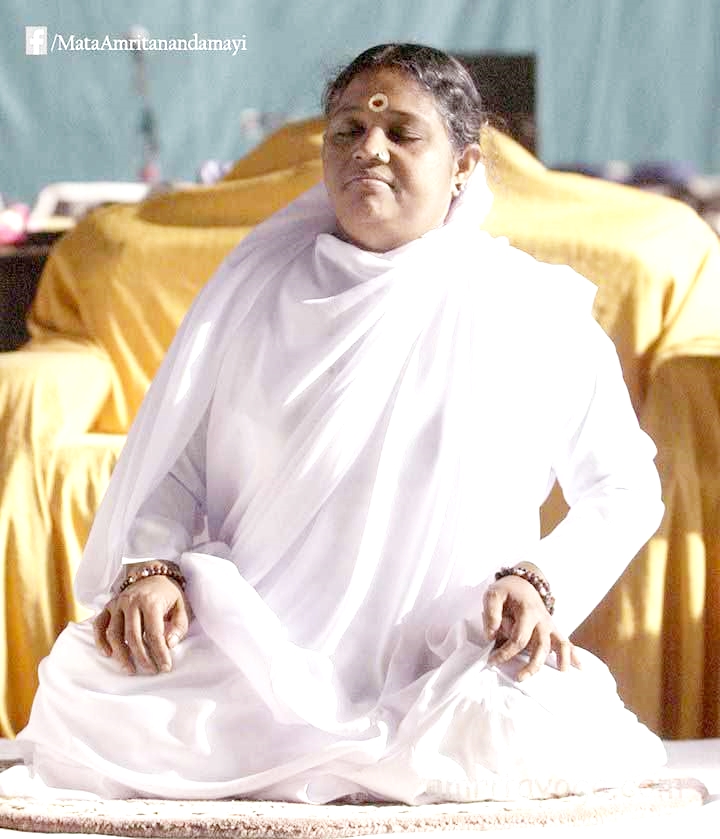
Connecting to the source
The Upanishads define hrdayam as the heart center or pure consciousness that is the abode of the Self and the source of wisdom. To live from the heart means to unfold the essentials of one’s existence by enlivening the deepest motives and intentions from within. Accessing the hrdayam leads to a more balanced life, inner intelligence, creativity and intuition, actual growth, personal effectiveness, and fulfillment. And this is living yoga. Amma says, “We should inquire into the very source of that power which exists within ourselves.”
Amma amply demonstrates her connection to the source through her epic darshans. For example, when asked by a journalist if she wasn’t tired of hugging millions of people, Amma responded that there is no tiredness if one is connected to the source of energy.
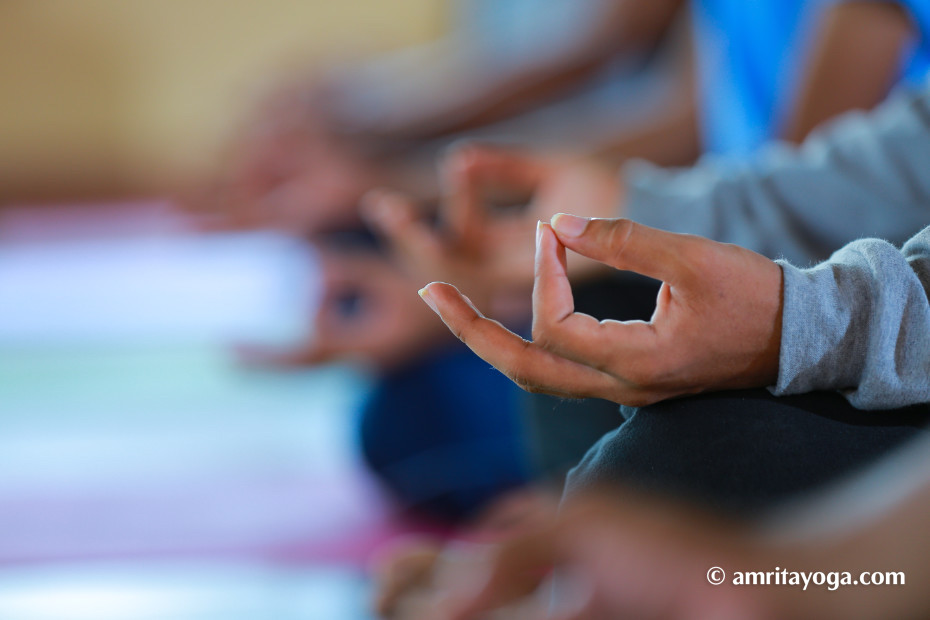
Amrita Yoga—a school of yoga
Mata Amritanandamayi Math is committed to a global outreach of Amrita Yoga. Stemming from ancient Indian spiritual traditions and a completely new approach based on Amma’s core philosophy of Living from the Heart, Amrita Yoga offers something for everyone, regardless of age or fitness level. Whether a beginner or an experienced practitioner, greater awareness and increased self-knowledge are priceless assets, and all these are cultivated breath by breath.
From the initial Kerala-specific focus, the program expanded to encompass devotees worldwide. Teachers from Mata Amritanandamayi Math’s more than 100 centers in India and 120 global centers reach people of all age groups in schools, universities, industrial organizations, corporations, and the like. In addition, the Math is also engaged in the massive project of teaching Amrita Yoga to India’s 2.5 million-strong paramilitary force. Globally, over 150,000 participants have participated in Amrita Yoga to date.
Since the start of the International Day of Yoga observance in 2015, the Ministry of AYUSH, Government of India, has given accreditation to Amrita Yoga to coordinate the promotion, propagation, and execution of its activities in India and abroad. Amrita Yoga has also been the official co-organizer of the IDY Celebrations along with the Indian Embassies in Denmark, Chicago, and Norway.
Amrita Yoga, a unique Hatha Yoga program, is inspired by Amma, who invites all to lead a peaceful, harmonious, and fulfilling life. It is an integrated approach to total wellness focusing on therapeutic yoga, psychosomatic and holistic health, and meditation.
Classes are designed as age-specific to cater to the lifestyles of children, youth, adults, and seniors. The practices were initiated and developed under Amma’s guidance. Such an opportunity for humankind is, in fact, something profound and rare.
